From Theoretical Framework to Empirical Investigation: A Bibliometric Analysis of Research Evolution and Emerging Trends in Polarity Sensitivity Studies Between 1980 and 2023
Abstract
1. Introduction
- How has the intellectual structure of polarity sensitivity research evolved over the past four decades, particularly concerning the integration of different theoretical approaches and methodological frameworks?
- What are the primary research clusters and collaboration patterns in polarity sensitivity research, and how have these patterns influenced the development of theoretical frameworks and empirical methodologies?
- What are the emerging trends and potential future directions in polarity sensitivity research, particularly concerning the integration of traditional theoretical approaches with new experimental and computational methodologies?
2. Materials and Methods
2.1. Data Source and Collection
- Search terms in WoS Core Collection databases: TS = (Polarity) OR TS = (PPI) OR TS = (NPI); Search terms in Scopus database: TITLE-ABS-KEY (Polarity OR PPI OR NPI)
- Select subject categories in the WoS Core Collection databases: “Linguistics”, “Language linguistics”, “Psychology Experimental”, “Neurosciences”, and “Psychology”. Explore subject Categories in the Scopus database: “Arts and Humanities”, “Psychology”, and “Neuroscience”.
- Limit research areas in WoS Core Collection databases: “psychology”, “linguistics”. “behavioural sciences”, “literature”, “communication”, “arts humanities”, and other topics; Limit keywords in Scopus database: Exclude keywords about Physiology, Pathophysiology, and Genetics, such as “Metabolism”, “Startle Reflex”, “Alzheimer Disease”, “Gene Expression Regulation”.
- Only peer-reviewed journal articles and reviews were included to ensure methodological consistency across bibliometric analyses (Aria & Cuccurullo, 2017; Chen, 2006; Van Eck & Waltman, 2010).
- Specify language: English
2.2. Analysis Procedure
3. Results
3.1. Analysis of Basic Information
3.1.1. Number and Growth Trend of Annual Publications
3.1.2. Primary Countries and Journals
3.1.3. Leading Authors
3.1.4. Language Coverage
3.2. Analyses of Research Hotspots
3.2.1. Literature Co-Citation
3.2.2. Top Keyword Co-Occurrence
3.3. Timeline Visualization Analysis
3.3.1. Emergence of Core Research Areas (1980–2000)
3.3.2. Modern Research Developments (2000–2010)
3.3.3. Contemporary Research Integration (2010–2023)
4. Discussion
4.1. Main Findings
4.2. Challenges and Future Development
5. Conclusions
Author Contributions
Funding
Institutional Review Board Statement
Informed Consent Statement
Data Availability Statement
Acknowledgments
Conflicts of Interest
| 1 | It is important to note that this method captures only languages referenced in titles and abstracts; studies where the target language is not explicitly stated may not be accounted for. |
| 2 | Cluster labels are automatically assigned based on the highest-ranking keyword (by LLR and p-value) (Chen, 2016). |
References
- Alemanno, F., Houdayer, E., Cursi, M., Velikova, S., Tettamanti, M., Comi, G., Cappa, S. F., & Leocani, L. (2012). Action-related semantic content and negation polarity modulate motor areas during sentence reading: An event-related desynchronization study. Brain Research, 1484, 39–49. [Google Scholar] [CrossRef] [PubMed]
- Aria, M., & Cuccurullo, C. (2017). Bibliometrix: An R-tool for comprehensive science mapping analysis. Journal of Informetrics, 11(4), 959–975. [Google Scholar] [CrossRef]
- Bickel, B. (2014). Linguistic diversity and universals. In N. J. Enfield, P. Kockelman, & J. Sidnell (Eds.), The Cambridge handbook of linguistic anthropology (pp. 101–124). Cambridge University Press. [Google Scholar]
- Carlson, G. N. (1980). Polarity any is existential. Linguistic Inquiry, 11(4), 799–804. [Google Scholar]
- Carstens, V., & Mletshe, L. (2016). Negative concord and nominal licensing in Xhosa and Zulu. Natural Language & Linguistic Theory, 34, 761–804. [Google Scholar]
- Chen, C. (2006). CiteSpace II: Detecting and visualizing emerging trends and transient patterns in scientific literature. Journal of the American Society for Information Science and Technology, 57(3), 359–377. [Google Scholar] [CrossRef]
- Chen, C. (2016). CiteSpace: A practical guide for mapping scientific literature. Nova Science Publishers Hauppauge. [Google Scholar]
- Cheng, L. L.-S., & Giannakidou, A. (2013). The non-uniformity of wh-indeterminates with polarity and free choice in Chinese. Strategies of Quantification, 44, 123. [Google Scholar] [CrossRef]
- Chierchia, G. (2004). Scalar implicatures, polarity, and the syntax-pragmatics interface. In A. Belletti (Ed.), Structures and beyond: The cartography of syntactic structures (Vol. 3, pp. 39–103). Oxford University Press. [Google Scholar]
- Chierchia, G. (2006). Broaden your views: Implicatures of domain widening and the “logicality” of language. Linguistic Inquiry, 37(4), 535–590. [Google Scholar] [CrossRef]
- Chierchia, G. (2013). Logic in grammar: Polarity, free choice, and intervention. Oxford University Press. [Google Scholar]
- Chomsky, N. (1995). The Minimalist Program. The MIT Press. [Google Scholar]
- Collins, C., Postal, P. M., & Yevudey, E. (2018). Negative polarity items in Ewe. Journal of Linguistics, 54(2), 331–365. [Google Scholar] [CrossRef]
- Dilip, M. J., & Kumar, R. (2019). Negative polarity items in Telugu. Acta Linguistica Asiatica, 9(1), 9–28. [Google Scholar] [CrossRef]
- Ding, X., & Yang, Z. (2020). Knowledge mapping of platform research: A visual analysis using VOSviewer and CiteSpace. Electronic Commerce Research, 22, 787–809. [Google Scholar] [CrossRef]
- Ernst, T. (2009). Speaker-oriented adverbs. Natural Language & Linguistic Theory, 27, 497–544. [Google Scholar]
- Fauconnier, G. (1975a). Polarity and the scale principle. Chicago Linguistics Society, 11, 188–199. [Google Scholar]
- Fauconnier, G. (1975b). Pragmatic scales and logical structure. Linguistic Inquiry, 6(3), 353–375. [Google Scholar]
- Gajewski, J. R. (2011). Licensing strong npis. Natural Language Semantics, 19, 109–148. [Google Scholar] [CrossRef]
- García-Marco, E., Morera, Y., Beltrán, D., de Vega, M., Herrera, E., Sedeño, L., Ibáñez, A., & García, A. M. (2019). Negation markers inhibit motor routines during typing of manual action verbs. Cognition, 182, 286–293. [Google Scholar] [CrossRef]
- Giannakidou, A. (1997). The landscape of polarity items [Ph.D. Dissertation, University of Groningen]. [Google Scholar]
- Giannakidou, A. (1998). Polarity sensitivity as (non) veridical dependency. John Benjamins Publishing Company. [Google Scholar]
- Giannakidou, A. (1999). Affective dependencies. Linguistics and Philosophy, 22, 367–421. [Google Scholar] [CrossRef]
- Giannakidou, A. (2001). The meaning of free choice. Linguistics and Philosophy, 24(6), 659–735. [Google Scholar] [CrossRef]
- Giannakidou, A. (2006). Only, emotive factive verbs, and the dual nature of polarity dependency. Language, 82(3), 575–603. [Google Scholar] [CrossRef]
- Giannakidou, A. (2009). The dependency of the subjunctive revisited: Temporal semantics and polarity. Lingua, 119(12), 1883–1908. [Google Scholar] [CrossRef]
- Giannakidou, A. (2011). Negative and positive polarity items: Variation, licensing, and compositionality. In C. Maienborn, K. von Heusinger, & P. Portner (Eds.), Semantics: An international handbook of natural language meaning. Mouton de Gruyter. [Google Scholar]
- Giannakidou, A. (2017). Evaluative subjunctive and nonveridicality. In Tense, mood, and modality: New answers to old questions (pp. 177–217). University of Chicago Press. [Google Scholar]
- Giannakidou, A., & Cheng, L. L.-S. (2006). (In) definiteness, polarity, and the role of wh-morphology in free choice. Journal of Semantics, 23(2), 135–183. [Google Scholar] [CrossRef]
- Giannakidou, A., & Quer, J. (2013). Exhaustive and non-exhaustive variation with free choice and referential vagueness: Evidence from Greek, Catalan, and Spanish. Lingua, 126, 120–149. [Google Scholar] [CrossRef]
- Giannakidou, A., von Heusinger, K., Maienborn, C., & Portner, P. (2019). Negative and positive polarity items. In P. Portner, C. Maienborn, & K. von Heusinger (Eds.), Semantics—Sentence and information structure (pp. 69–134). De Gruyter Mouton. [Google Scholar]
- Giannakidou, A., & Yoon, S. (2011). The subjective mode of comparison: Metalinguistic comparatives in Greek and Korean. Natural Language & Linguistic Theory, 29, 621–655. [Google Scholar]
- Giannakidou, A., & Yoon, S. (2024). Rethinking negative polarity and free choice in comparatives: A crosslinguistic perspective. TABU Festschrift for Jack Hoeksema, 38, 30–56. [Google Scholar] [CrossRef]
- Haspelmath, M. (1997). Indefinite pronouns. Oxford University Press. [Google Scholar]
- Hoeksema, J. (1983). Negative polarity and the comparative. Natural Language & Linguistic Theory, 1, 403–434. [Google Scholar]
- Hoeksema, J. (1986). Monotonicity phenomena in natural language. In J. Gutiérrez-Rexach (Ed.), Semantics: Critical concepts in linguistics (pp. 121–135). Routledge. [Google Scholar]
- Hoeksema, J. (1994). On the grammaticalization of negative polarity items. In S. Gahl, A. Dolbey, & C. Johnson (Eds.), Annual Meeting of the Berkeley Linguistics Society (pp. 273–282). Berkeley Linguistics Society. [Google Scholar]
- Hoeksema, J. (1998). On the (non)loss of polarity sensitivity: Dutch ooit. In R. Mogg, & L. van Bergen (Eds.), Historical Linguistics 1995: Volume 2: Germanic linguistics (pp. 101–114). Benjamins. [Google Scholar]
- Hoeksema, J. (2010). Dutch ENIG: From nonveridicality to downward entailment. Natural Language & Linguistic Theory, 28, 837–859. [Google Scholar]
- Holmberg, A. (2013). The syntax of answers to polar questions in English and Swedish. Lingua, 128, 31–50. [Google Scholar] [CrossRef]
- Horn, L. R. (1972). On the semantic properties of logical operators in English. University of California, Los Angeles. [Google Scholar]
- Horn, L. R. (1989). A natural history of negation (Vol. 24). University of Chicago Press. [Google Scholar]
- Horn, L. R. (2000). Any and (-) ever: Free choice and free relatives. In A. Z. Wyner (Ed.), Proceedings of the 15th annual conference of the Israeli association for theoretical linguistics (Vol. 15, pp. 71–111). Israeli Association for Theoretical Linguistics. [Google Scholar]
- Iatridou, S., & Zeijlstra, H. (2013). Negation, polarity, and deontic modals. Linguistic Inquiry, 44(4), 529–568. [Google Scholar] [CrossRef]
- Kadmon, N., & Landman, F. (1993). Any. Linguistics and Philosophy, 16, 353–422. [Google Scholar] [CrossRef]
- Krifka, M. (2015). Bias in commitment space semantics: Declarative questions, negated quetions, and question tags. In S. D’Antonio, M. Moroney, & C. R. Littl (Eds.), Proceedings of SALT 25 (pp. 328–345). LSA Open Journal Systems. [Google Scholar]
- Krika, M. (1995). The semantics and pragmatics of polarity items. Linguistic Analysis, 25, 209–257. [Google Scholar]
- Ladusaw, W. A. (1979). Polarity sensitivity as inherent scope relations [Dotoral Dissertation, The University of Texas]. [Google Scholar]
- Ladusaw, W. A. (1983). Logical form and conditions on grammaticality. Linguistics and Philosophy, 6(3), 373–392. [Google Scholar] [CrossRef]
- Lahiri, U. (1998). Focus and negative polarity in Hindi. Natural Language Semantics, 6(1), 57–123. [Google Scholar] [CrossRef]
- Laka Mugarza, M. I. (1990). Negation in syntax—On the nature of functional categories and projections [Dotoral Dissertation, Massachusetts Institute of Technology]. [Google Scholar]
- Lee, C. (2003). Negative polarity items and free choice in Korean and Japanese: A contrastive study. Korean Society of Bilingualism, 22, 1–48. [Google Scholar]
- Linebarger, M. C. (1980). The grammar of negative polarity [Dotoral Dissertation, Massachusetts Institute of Technology]. [Google Scholar]
- Linebarger, M. C. (1987). Negative polarity and grammatical representation. Linguistics and Philosophy, 10(3), 325–387. [Google Scholar] [CrossRef]
- Linebarger, M. C. (1991). Negative polarity as linguistic evidence. Chicago Linguistic Society, 27(2), 165–188. [Google Scholar]
- Newman, M. E. (2006). Modularity and community structure in networks. Proceedings of the National Academy of Sciences, 103(23), 8577–8582. [Google Scholar] [CrossRef]
- Orth, W., Yoshida, M., & Sloggett, S. (2021). Negative polarity item (NPI) illusion is a quantification phenomenon. Journal of Experimental Psychology: Learning, Memory, and Cognition, 47(6), 906. [Google Scholar] [CrossRef]
- Progovac, L. (1992). Negative polarity: A semantico-syntactic approach. Lingua, 86(4), 271–299. [Google Scholar] [CrossRef]
- Rousseeuw, P. J. (1987). Silhouettes: A graphical aid to the interpretation and validation of cluster analysis. Journal of Computational and Applied Mathematics, 20, 53–65. [Google Scholar] [CrossRef]
- Schwab, J., Liu, M., & Mueller, J. L. (2021). On the acquisition of polarity items: 11-to 12-year-olds’ comprehension of German NPIs and PPIs. Journal of Psycholinguistic Research, 50(6), 1487–1509. [Google Scholar] [CrossRef]
- Sitaridou, I. (2014). Modality, antiveridicality and complementation: The Romeyka infinitive as a negative polarity item. Lingua, 148, 118–146. [Google Scholar] [CrossRef]
- Steinhauer, K., Drury, J. E., Portner, P., Walenski, M., & Ullman, M. T. (2010). Syntax, concepts, and logic in the temporal dynamics of language comprehension: Evidence from event-related potentials. Neuropsychologia, 48(6), 1525–1542. [Google Scholar] [CrossRef] [PubMed]
- Tieu, L., & Lidz, J. (2016). NPI licensing and beyond: Children’s knowledge of the semantics of any. Language Acquisition, 23(4), 311–332. [Google Scholar] [CrossRef]
- Van Eck, N., & Waltman, L. (2010). Software survey: VOSviewer, a computer program for bibliometric mapping. Scientometrics, 84(2), 523–538. [Google Scholar] [CrossRef]
- Van Rooy, R. (2003). Negative polarity items in questions: Strength as relevance. Journal of Semantics, 20(3), 239–273. [Google Scholar] [CrossRef]
- Vasishth, S., Brüssow, S., Lewis, R. L., & Drenhaus, H. (2008). Processing polarity: How the ungrammatical intrudes on the grammatical. Cognitive Science, 32(4), 685–712. [Google Scholar] [CrossRef]
- Xiang, M., Dillon, B., & Phillips, C. (2009). Illusory licensing effects across dependency types: ERP evidence. Brain and Language, 108(1), 40–55. [Google Scholar] [CrossRef]
- Yanilmaz, A., & Drury, J. E. (2018). Prospective NPI licensing and intrusion in Turkish. Language, Cognition and Neuroscience, 33(1), 111–138. [Google Scholar] [CrossRef]
- Zwarts, F. (1996). A hierarchy of negative expressions. In H. Wansing (Ed.), Negation: A notion in focus (pp. 169–194). Walter de Gruyter GmbH. [Google Scholar]
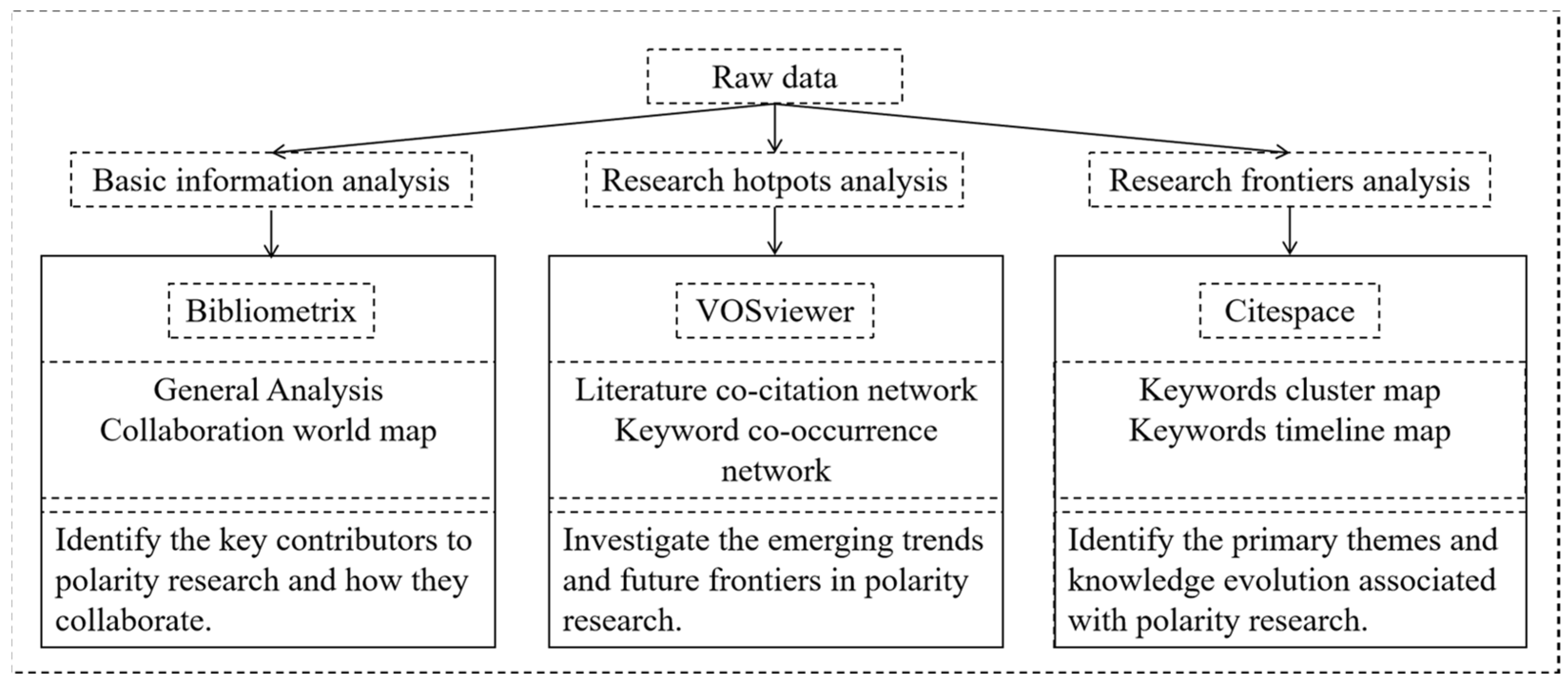
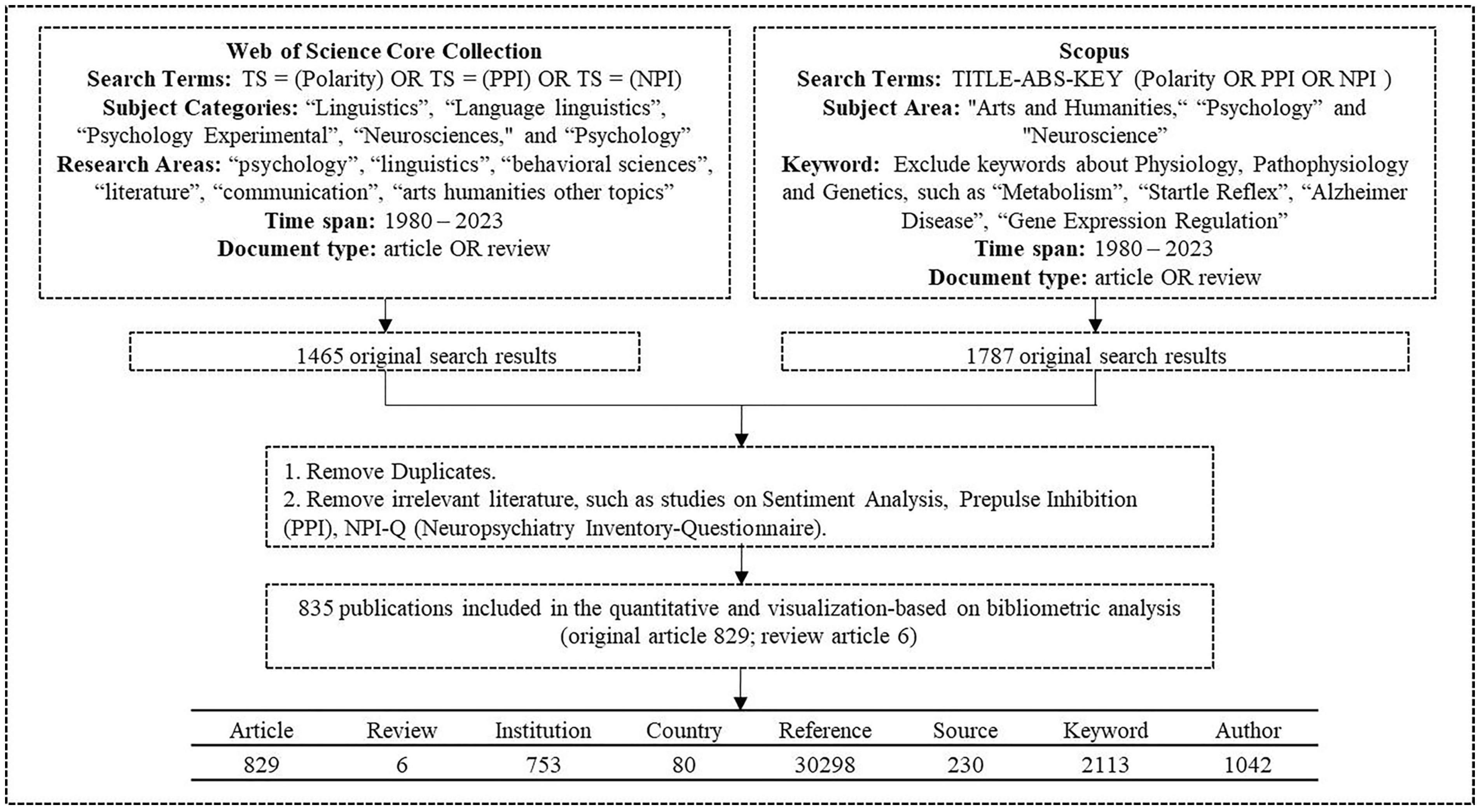


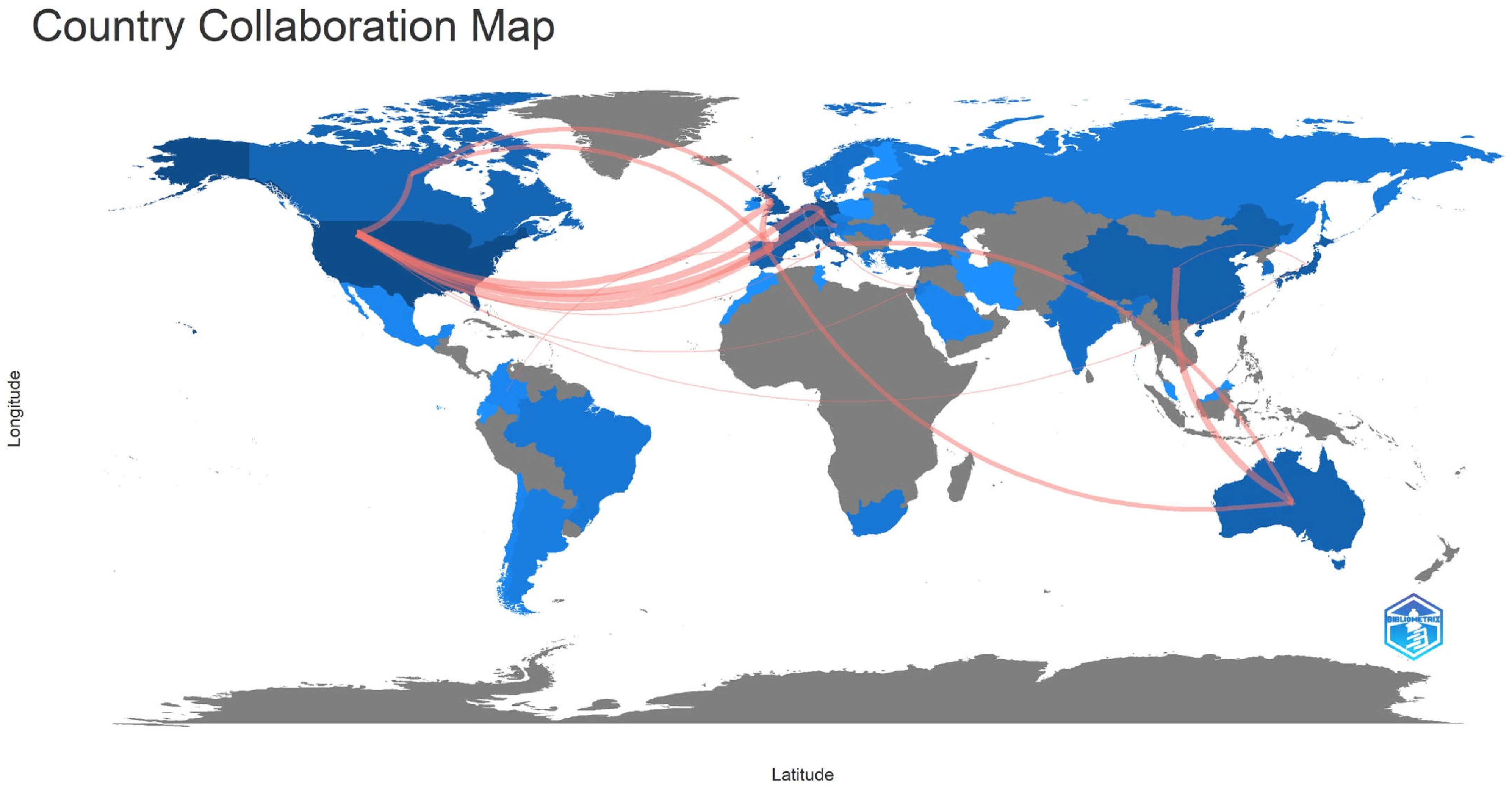
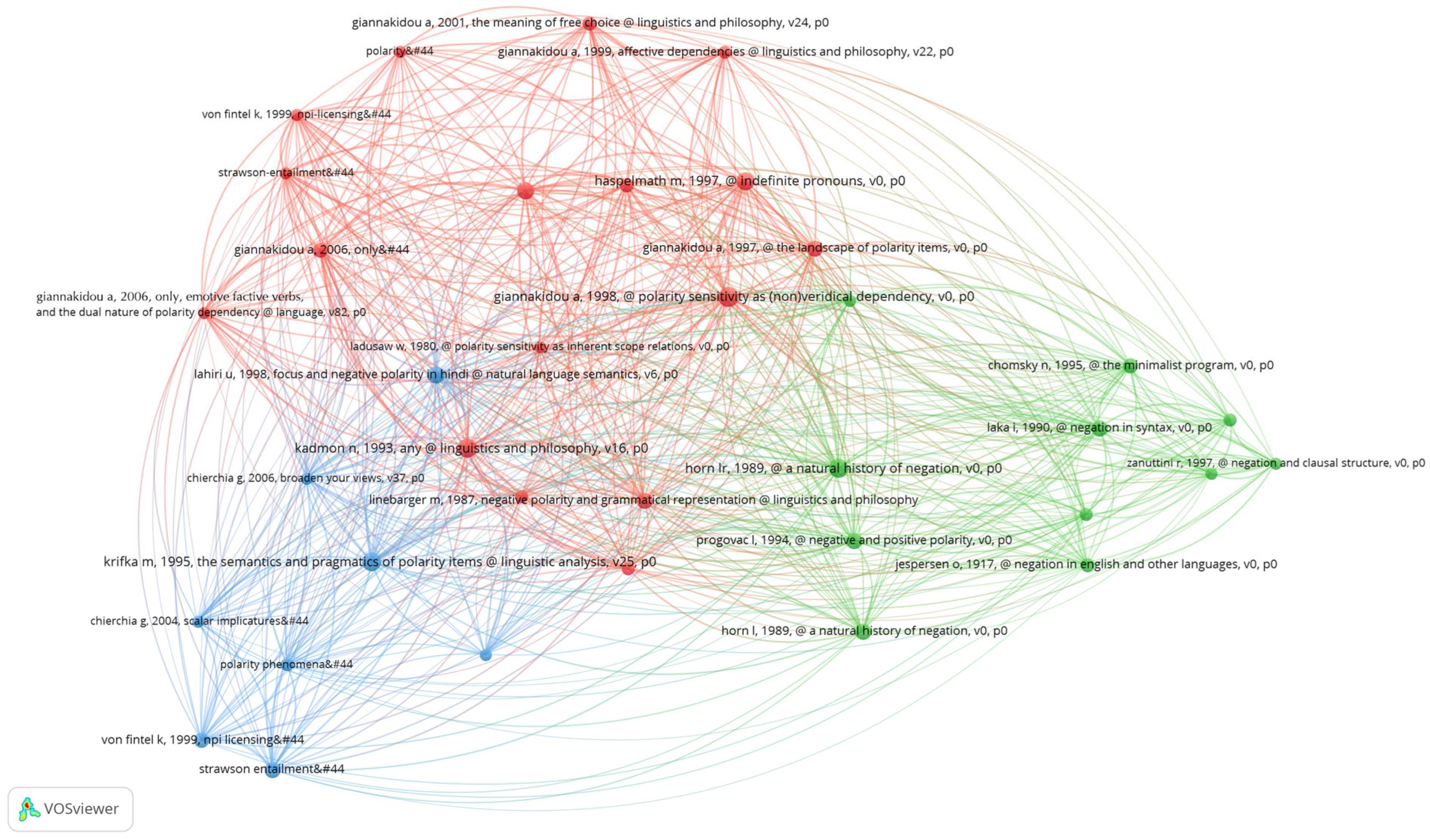
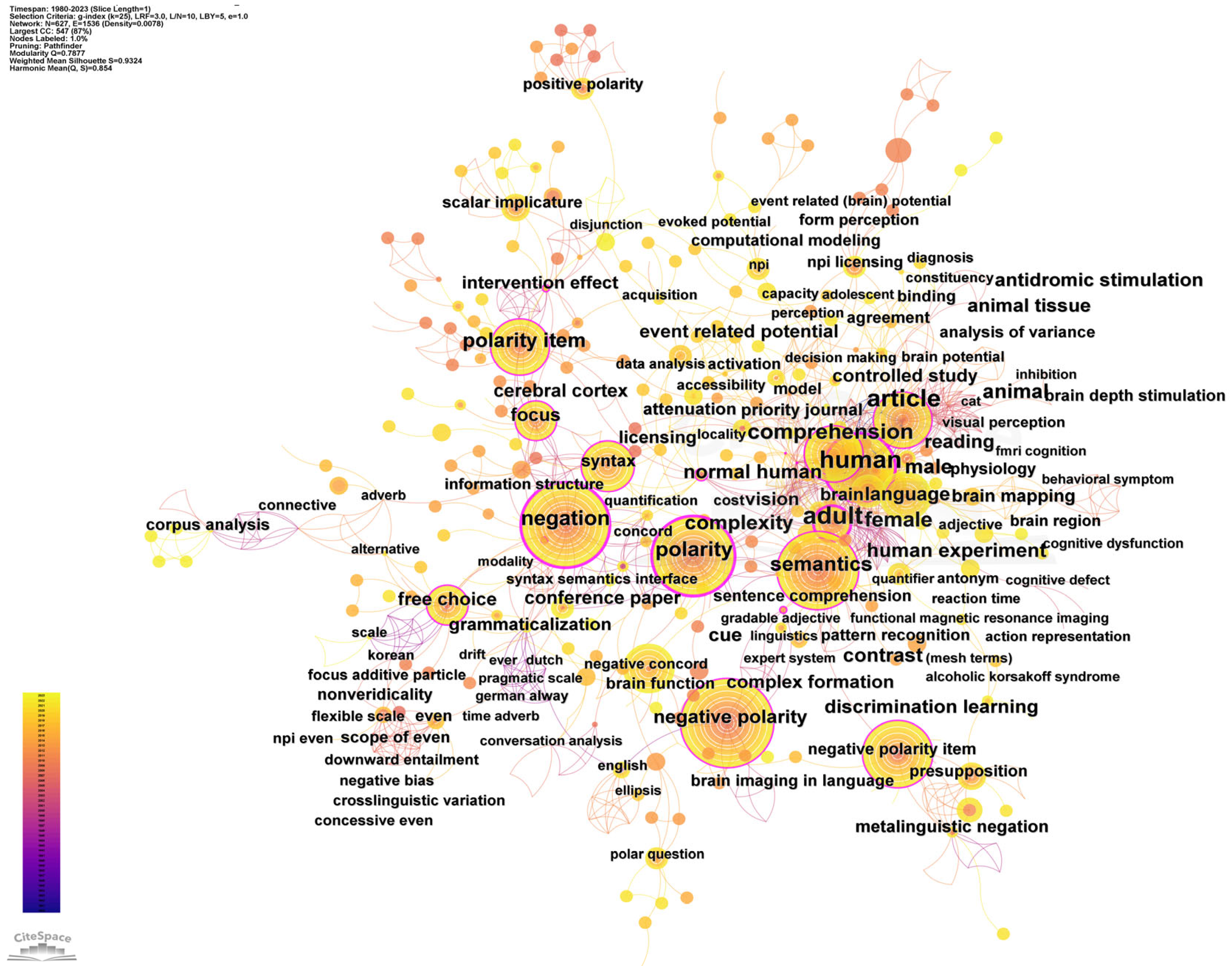
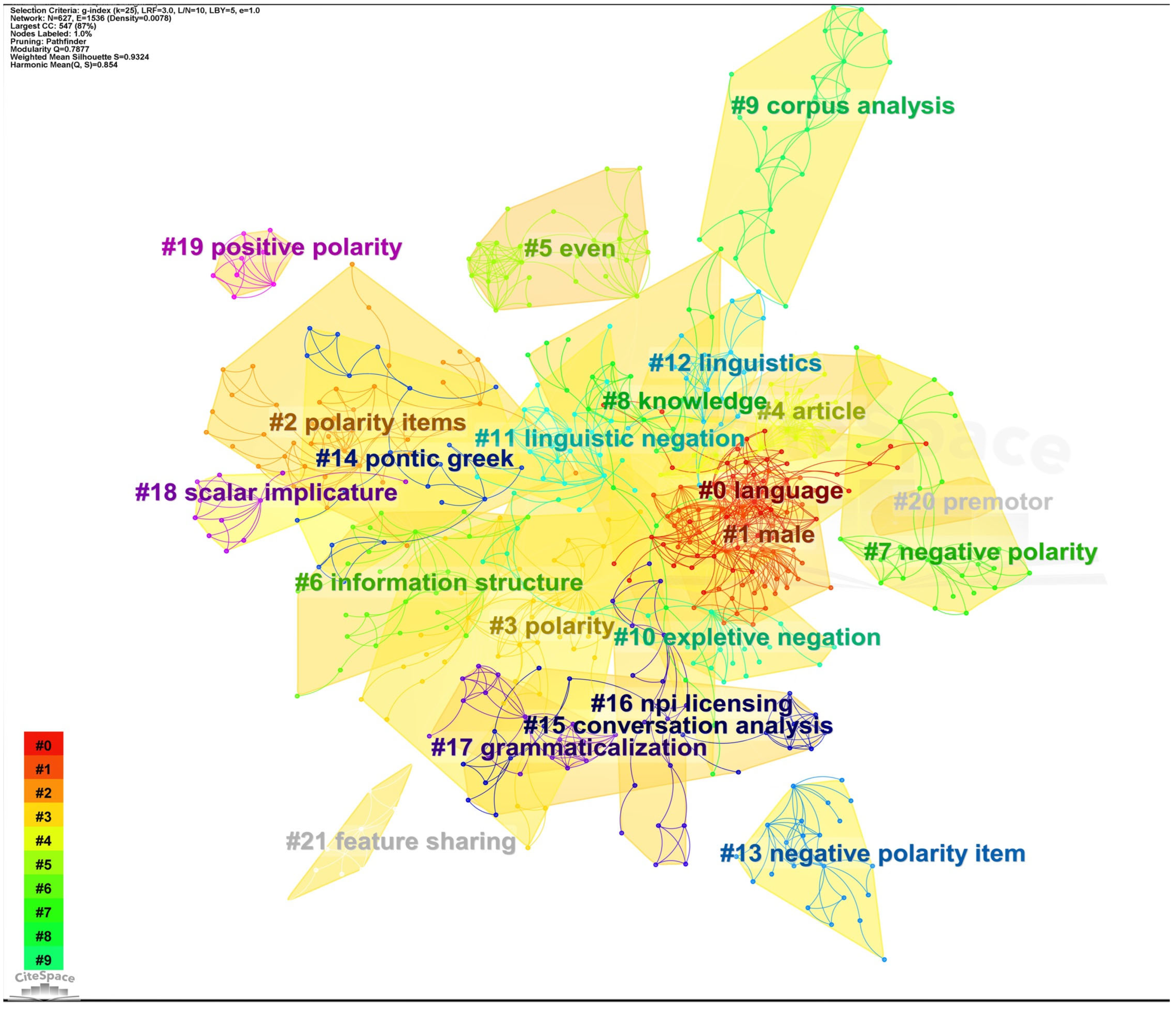

| Country | Average Citation | Region | Article | Affiliation | Article |
|---|---|---|---|---|---|
| USA | 17.6 | USA | 298 | University of Chicago | 21 |
| Germany | 9 | Germany | 155 | University of Groningen | 20 |
| United Kingdom | 7.1 | United Kingdom | 99 | University of Amsterdam | 19 |
| Spain | 10.2 | Netherlands | 96 | University of Connecticut | 18 |
| Netherlands | 7.8 | France | 71 | Univ Autonoma Barcelona | 15 |
| Canada | 12.1 | Japan | 65 | Hebrew Univ Jerusalem | 14 |
| Italy | 8.7 | Spain | 61 | New York University | 14 |
| China | 4.2 | China | 58 | Harvard University | 13 |
| France | 4.3 | Israel | 43 | Macquarie University | 12 |
| Israel | 7.2 | Australia | 42 | University of Tübingen | 12 |
| Sources | Articles | h-Index | m-Index | PY Start |
|---|---|---|---|---|
| Lingua | 86 | 10 | 0.294 | 1990 |
| Natural Language and Linguistic Theory | 50 | 8 | 0.288 | 1994 |
| Natural Language Semantics | 48 | 8 | 0.286 | 1996 |
| Journal of Semantics | 42 | 4 | 0.143 | 1996 |
| Linguistics | 37 | 3 | 0.07 | 1981 |
| Linguistics And Philosophy | 37 | 5 | 0.135 | 1987 |
| Glossa—A Journal of General Linguistics | 31 | 4 | 0.667 | 2018 |
| Journal of Psycholinguistic Research | 26 | 4 | 0.667 | 2018 |
| Journal of Pragmatics | 22 | 4 | 0.154 | 1998 |
| Journal of Neurolinguistics | 19 | 4 | 0.267 | 2009 |
| Discipline | Author | Article | Articles Fractionalised | Discipline | Author | Local Citation |
|---|---|---|---|---|---|---|
| Theoretical Linguistics | Giannakidou, A | 31 | 24 | Theoretical Linguistics | Giannakidou, A | 125 |
| Hoeksema, J | 26 | 23.33 | Gajewski, Jr | 105 | ||
| Gajewski, J | 16 | 14.5 | De Swart, H | 56 | ||
| Espinal, M | 14 | 5.75 | Psycholinguistics | Chierchia, G | 102 | |
| Homer, V | 14 | 7.33 | Drenhaus, H | 90 | ||
| Nishiguchi, S | 14 | 14 | Phillips, C | 84 | ||
| Collins, C | 12 | 8 | Frisch, S | 78 | ||
| Crain, S | 24 | 9.26 | Saddy, D | 78 | ||
| Psycholinguistics | Zeijlstra, H | 23 | 13 | Xiang, M | 64 | |
| Liu, M | 15 | 8.08 | Zeijlstra, H | 59 |
| Region | Language | Count | Region | Language | Count |
|---|---|---|---|---|---|
| Europe/Global | English | 197 | Northern Europe | Swedish | 5 |
| Southern Europe | Greek | 36 | Finnish | 4 | |
| Spanish | 32 | Danish | 3 | ||
| Italian | 32 | Norwegian | 2 | ||
| Portuguese | 20 | East Asia | Japanese | 49 | |
| Catalan | 19 | Chinese | 48 | ||
| Basque | 3 | Korean | 25 | ||
| Galician | 1 | Western Asia/Caucasus | Turkey | 4 | |
| Western Europe | French | 56 | Azerbaijani | 2 | |
| German | 37 | Armenian | 1 | ||
| Eastern Europe | Romanian | 17 | South Asia | Hindi | 11 |
| Hungarian | 11 | Urdu | 4 | ||
| Russian | 11 | Telugu | 1 | ||
| Croatian | 5 | Southeast Asia | Vietnamese | 2 | |
| Polish | 4 | Thai | 1 | ||
| Bulgarian | 2 | Malay | 1 | ||
| Czech | 2 | Middle East | Arabic | 13 | |
| Slovenian | 2 | Hebrew | 12 | ||
| Serbian | 1 | Africa | Zulu | 2 | |
| Other | Estonian | 4 | Swahili | 1 |
| Paper | Total Citation | Normalised Total Citation |
|---|---|---|
| Xiang et al. (2009), Brain Lang. | 102 | 9.7541 |
| Vasishth et al. (2008), Cognitive Sci. | 85 | 18.9402 |
| Giannakidou (2009), Lingua | 80 | 7.65027 |
| Ernst (2009), Nat. Lang. Linguist. Theo. | 63 | 6.02459 |
| Gajewski (2011), Nat. Lang. Semant. | 46 | 13.2692 |
| Iatridou and Zeijlstra (2013), Linguist. Inq. | 45 | 9.60191 |
| Holmberg (2013), Lingua. | 44 | 9.38854 |
| Steinhauer et al. (2010), Neuropsychologia | 41 | 4.99045 |
| Keywords | Count | Centrality |
|---|---|---|
| negation | 92 | 0.26 |
| polarity | 85 | 0.3 |
| negative polarity item | 72 | 0.12 |
| negative polarity | 71 | 0.11 |
| semantics | 41 | 0.2 |
| human | 39 | 0.25 |
| polarity item | 36 | 0.19 |
| language | 34 | 0.04 |
| negative concord | 32 | 0.05 |
| comprehension | 31 | 0.15 |
| Size | Silhouette | Mean Number of Years | Top Terms (LLR, p-Level) |
|---|---|---|---|
| 48 | 0.771 | 2008 | language (30.56, 0.0001); human (28.74, 0.0001); comprehension (26.62, 0.0001); child (22.19, 0.0001); reading (21.68, 0.0001) |
| 47 | 0.933 | 2007 | male (11.9, 0.001); female (11.9, 0.001); temporal lobe (10.23, 0.005); executive function (10.23, 0.005); middle aged (10.23, 0.005) |
| 44 | 0.927 | 2009 | polarity items (24.46, 0.0001); polarity item (19.74, 0.0001); negative polarity items (NPIs) (17.8, 0.0001); intervention effect (17.8, 0.0001); xml (11.85, 0.001) |
| 44 | 0.94 | 2008 | polarity (58.68, 0.0001); negation (50.51, 0.0001); human (12.68, 0.001); gradable adjective (12.48, 0.001); verb movement (12.48, 0.001) |
| 33 | 0.956 | 2006 | article (10.12, 0.005); analysis of variance (9.97, 0.005); electroretinography (9.51, 0.005); optic nerve (9.51, 0.005); retina (9.51, 0.005) |
| 27 | 0.998 | 2007 | even (25.07, 0.0001); free choice (14.58, 0.001); sub triggering (14.1, 0.001); locality (14.1, 0.001); referential deficiency (14.1, 0.001) |
| 26 | 0.975 | 2011 | information structure (37.61, 0.0001); focus (30.18, 0.0001); topic comment (12.46, 0.001); polarity correction (12.46, 0.001); polarity contrast (12.46, 0.001) |
| 25 | 0.918 | 2009 | negative polarity (57.28, 0.0001); negative concord (51.27, 0.0001); double negation (11.45, 0.001); indefinite pronoun (10.52, 0.005); Russian (10.52, 0.005) |
| 25 | 0.894 | 2010 | knowledge (34.16, 0.0001); computational modelling (34.16, 0.0001); category learning (27.27, 0.0001); judgment (17.91, 0.0001); decision making (16.44, 0.0001) |
| 24 | 0.925 | 2010 | corpus analysis (31.32, 0.0001); enantiomers (15.57, 0.0001); lexical pragmatics (15.57, 0.0001); connective (15.57, 0.0001); alternative (11.79, 0.001) |
Disclaimer/Publisher’s Note: The statements, opinions and data contained in all publications are solely those of the individual author(s) and contributor(s) and not of MDPI and/or the editor(s). MDPI and/or the editor(s) disclaim responsibility for any injury to people or property resulting from any ideas, methods, instructions or products referred to in the content. |
© 2025 by the authors. Licensee MDPI, Basel, Switzerland. This article is an open access article distributed under the terms and conditions of the Creative Commons Attribution (CC BY) license (https://creativecommons.org/licenses/by/4.0/).
Share and Cite
Kong, L.; Li, Y.; Sun, Y.; Jiang, Y.; Jiang, X. From Theoretical Framework to Empirical Investigation: A Bibliometric Analysis of Research Evolution and Emerging Trends in Polarity Sensitivity Studies Between 1980 and 2023. Languages 2025, 10, 119. https://doi.org/10.3390/languages10060119
Kong L, Li Y, Sun Y, Jiang Y, Jiang X. From Theoretical Framework to Empirical Investigation: A Bibliometric Analysis of Research Evolution and Emerging Trends in Polarity Sensitivity Studies Between 1980 and 2023. Languages. 2025; 10(6):119. https://doi.org/10.3390/languages10060119
Chicago/Turabian StyleKong, Lingda, Yi Li, Yanting Sun, Yong Jiang, and Xiaoming Jiang. 2025. "From Theoretical Framework to Empirical Investigation: A Bibliometric Analysis of Research Evolution and Emerging Trends in Polarity Sensitivity Studies Between 1980 and 2023" Languages 10, no. 6: 119. https://doi.org/10.3390/languages10060119
APA StyleKong, L., Li, Y., Sun, Y., Jiang, Y., & Jiang, X. (2025). From Theoretical Framework to Empirical Investigation: A Bibliometric Analysis of Research Evolution and Emerging Trends in Polarity Sensitivity Studies Between 1980 and 2023. Languages, 10(6), 119. https://doi.org/10.3390/languages10060119






